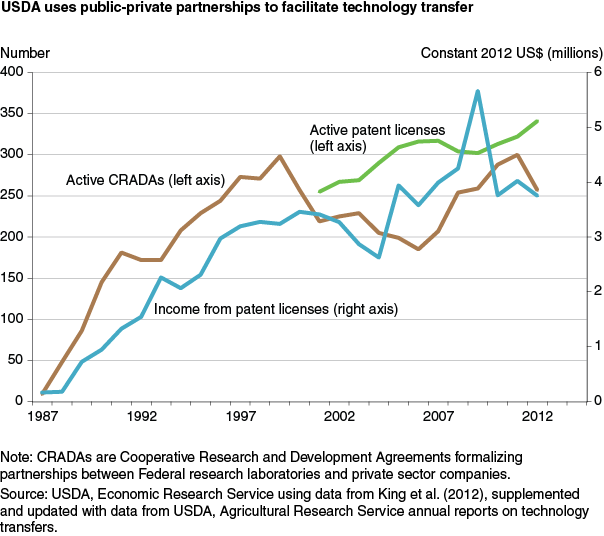Public-Private Partnerships Create Opportunities To Enhance the Agricultural Research System
- by Andrew A. Toole
- 11/18/2013
The U.S. agricultural research system has a long history of contributing new knowledge and technologies that fuel worldwide improvements in agricultural production, food safety, and nutrition. This system, however, is undergoing fundamental change. Traditional public funding for agricultural research and development (R&D) has stagnated over the past several decades. At the same time, private companies are financing and performing a growing share of overall food and agricultural R&D. As the agricultural research system continues to evolve, one of the most pressing questions is how to leverage public resources and foster innovation.
To address this question, public research institutions have developed strategies for partnering with private firms. A series of legislative initiatives starting in the 1980s, such as the Bayh-Dole Act of 1980 and the Federal Technology Transfer Act of 1986, established legal frameworks that promote and support greater public-private research collaboration and technology transfer. The Bayh-Dole Act made it easier for universities and other performers of federally sponsored research to patent and license their research results. Patenting and licensing facilitates technology transfer when additional development by a private-sector partner is needed to produce a commercial product. The license may provide exclusive rights to market the product as a way of reducing commercial risk to the company. In 2012, USDA had 341 active patent licenses earning over $3.7 million.
When the nature of R&D requires closer interaction, Federal laboratories can enter into partnerships using Cooperative Research and Development Agreements (CRADAs) created by the Federal Technology Transfer Act. CRADAs are flexible contracts that can be used to transfer technologies or advance research while protecting proprietary information and the assignment of intellectual property rights. Partnerships can include for-profit companies, not-for-profit organizations, State or local governments, and other Federal agencies. USDA’s CRADA program has been operating longer and has had more agreements per appropriated dollar than similar programs operated by any other Federal agency.
While partnerships enable private companies to develop new food and agricultural products at lower costs by leveraging a strong public science base, these arrangements could also divert public research away from its central mission. Further analysis is necessary before the full value of public-private partnerships can be assessed, but anecdotal evidence and case studies suggest such partnerships can stimulate agricultural innovation and help offset inflation-adjusted cuts in public support for agricultural R&D.
This article is drawn from:
- King, J., Toole, A.A. & Fuglie, K. (2012). The Complementary Roles of the Public and Private Sectors in U.S. Agricultural Research and Development. U.S. Department of Agriculture, Economic Research Service. EB-19.
You may also like:
- Heisey, P., King, J., Day Rubenstein, K., Bucks, D. & Welsh, R. (2010). Assessing the Benefits of Public Research Within an Economic Framework: The Case of USDA's Agricultural Research Service. U.S. Department of Agriculture, Economic Research Service. ERR-95.
- Heisey, P., King, J., Day Rubenstein, K. & Shoemaker, R. (2006). Government Patenting and Technology Transfer. U.S. Department of Agriculture, Economic Research Service. ERR-15.


